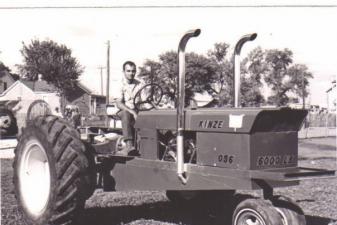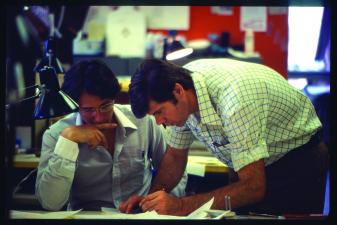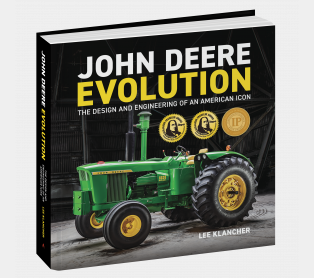John Deere Evolution: Kinzenbaw Powers up Again

John Deere Evolution is a visually stunning work that blends tractors photographed in custom-built studios with concept drawings and behind-the-scenes looks at how the machines were designed and built. This encyclopedic history covers every model line built by John Deere since 1919. In this excerpt from the book, read about Jon Kinzenbaw repowering the 8430 and 8630.
Jon Kinzenbaw’s business repowering tractors had peaked with the 5020 and dropped off when Deere offered the high-horsepower 6030. His business shifted toward building innovative wagons and implements, most for large operations. He also constructed Big Blue, a 20-ton twin-engine, four-wheel-drive tractor that coupled a 6030 with a salvaged 5020.
When the new high-horsepower, four-wheel-drive 8430 and 8630 were introduced for the 1975 season, Kinzenbaw’s father-in-law purchased one . . . which put Kinze back in the repower business.
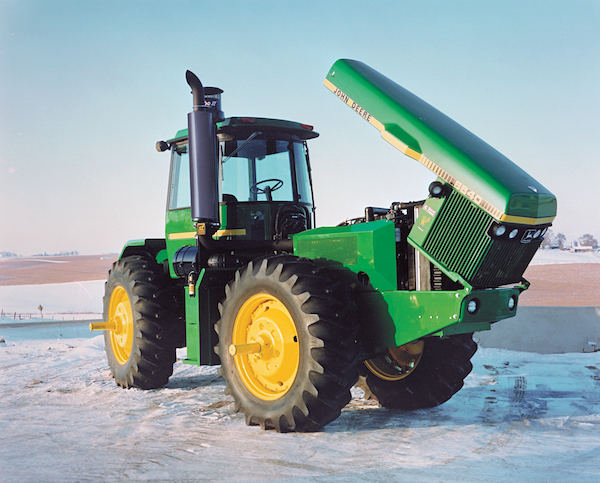 Kinze Manufacturing began repowering the 8430 and 8630 with Cummins diesel engines The modifications included a new frame under the engine and a tilt-up hood. Photo courtesy of the Kinzenbaw Collection.
Kinze Manufacturing began repowering the 8430 and 8630 with Cummins diesel engines The modifications included a new frame under the engine and a tilt-up hood. Photo courtesy of the Kinzenbaw Collection.
“My father-in-law had a new 8630, and we discovered that he had a bad engine,” Kinzenbaw said. Deere offered a replacement engine for about $5,000. They soon discovered that engine failures were a persistent problem with these models.
“I remember one day we had two guys call in with 8630s and they said, ‘Yeah, that dirty son of a gun knocked a rod out and the rod came out of the side of the block and knocked the starter right out on the fuel tank.’ My employee that was working for me said, ‘That’s not all. I had two guys within an hour call with the same problem.’”
Kinzenbaw believes the cause of the issue was that the design used the engine as a stressed member of the frame. This put pressure on the engine block. “It was the way they hung 10,000 pounds of front axle onto that engine block,” Kinzenbaw said.
He believes the stress the design placed on the engine block, combined with the changes in metallurgy from the block heating up to operating temperature and cooling down, would twist the engine block, which would in turn push engine cylinder sleeves out of place.
The factory fix, in his opinion, was not adequate. “Deere [was] pulling the head off, raising the sleeve up, and slipping a shim around [the] sleeve,” he said. “If you have a foundation crushing under your building, you don’t jack it up and put planks between it just to make the building the right height. It’s going to settle some more.”
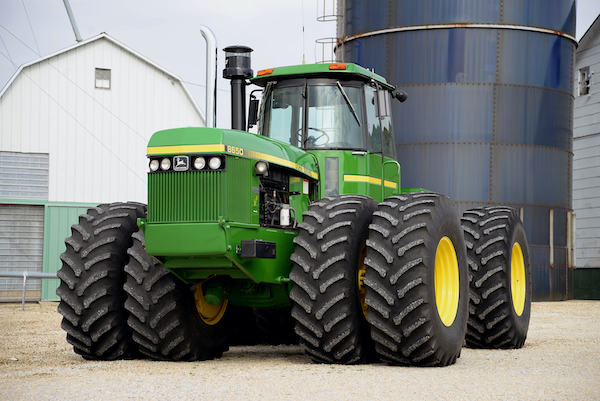 Kinze also repowered the 8650 machines. Photo courtesy of David Wawak / Super T.
Kinze also repowered the 8650 machines. Photo courtesy of David Wawak / Super T.
“I knew that if you went to a salvage yard and found anything from the 1920s all the way through, you’d always find that the original engine block was in those old tractors,” Kinzenbaw said. “If you had a John Deere four-wheel drive and it was in the salvage yard, half of the time they had a different engine in them.”
The Kinzenbaw team eventually decided there was an opportunity. “We decided we should get back in and repower those four-wheel drives,” Kinzenbaw said.
The starting point was to install a new engine—typically a Cummins 855—and construct a front axle frame to take the stress off the engine. The Cummins 855 is one of the outstanding engines of the era, a turbo-charged inline six-cylinder diesel that had rock solid reliability and could be tuned to produce more than 500 horsepower.
Grab your own copy of John Deere Evolution to keep reading "Kinzenbaw Powers up Again."
Jon Kinzenbaw’s business repowering tractors had peaked with the 5020 and dropped off when Deere offered the high-horsepower 6030. His business shifted toward building innovative wagons and implements, most for large operations. He also constructed Big Blue, a 20-ton twin-engine, four-wheel-drive tractor that coupled a 6030 with a salvaged 5020.
When the new high-horsepower, four-wheel-drive 8430 and 8630 were introduced for the 1975 season, Kinzenbaw’s father-in-law purchased one . . . which put Kinze back in the repower business.
 Kinze Manufacturing began repowering the 8430 and 8630 with Cummins diesel engines The modifications included a new frame under the engine and a tilt-up hood. Photo courtesy of the Kinzenbaw Collection.
Kinze Manufacturing began repowering the 8430 and 8630 with Cummins diesel engines The modifications included a new frame under the engine and a tilt-up hood. Photo courtesy of the Kinzenbaw Collection.“My father-in-law had a new 8630, and we discovered that he had a bad engine,” Kinzenbaw said. Deere offered a replacement engine for about $5,000. They soon discovered that engine failures were a persistent problem with these models.
“I remember one day we had two guys call in with 8630s and they said, ‘Yeah, that dirty son of a gun knocked a rod out and the rod came out of the side of the block and knocked the starter right out on the fuel tank.’ My employee that was working for me said, ‘That’s not all. I had two guys within an hour call with the same problem.’”
Kinzenbaw believes the cause of the issue was that the design used the engine as a stressed member of the frame. This put pressure on the engine block. “It was the way they hung 10,000 pounds of front axle onto that engine block,” Kinzenbaw said.
He believes the stress the design placed on the engine block, combined with the changes in metallurgy from the block heating up to operating temperature and cooling down, would twist the engine block, which would in turn push engine cylinder sleeves out of place.
The factory fix, in his opinion, was not adequate. “Deere [was] pulling the head off, raising the sleeve up, and slipping a shim around [the] sleeve,” he said. “If you have a foundation crushing under your building, you don’t jack it up and put planks between it just to make the building the right height. It’s going to settle some more.”
 Kinze also repowered the 8650 machines. Photo courtesy of David Wawak / Super T.
Kinze also repowered the 8650 machines. Photo courtesy of David Wawak / Super T.“I knew that if you went to a salvage yard and found anything from the 1920s all the way through, you’d always find that the original engine block was in those old tractors,” Kinzenbaw said. “If you had a John Deere four-wheel drive and it was in the salvage yard, half of the time they had a different engine in them.”
The Kinzenbaw team eventually decided there was an opportunity. “We decided we should get back in and repower those four-wheel drives,” Kinzenbaw said.
The starting point was to install a new engine—typically a Cummins 855—and construct a front axle frame to take the stress off the engine. The Cummins 855 is one of the outstanding engines of the era, a turbo-charged inline six-cylinder diesel that had rock solid reliability and could be tuned to produce more than 500 horsepower.
Grab your own copy of John Deere Evolution to keep reading "Kinzenbaw Powers up Again."


